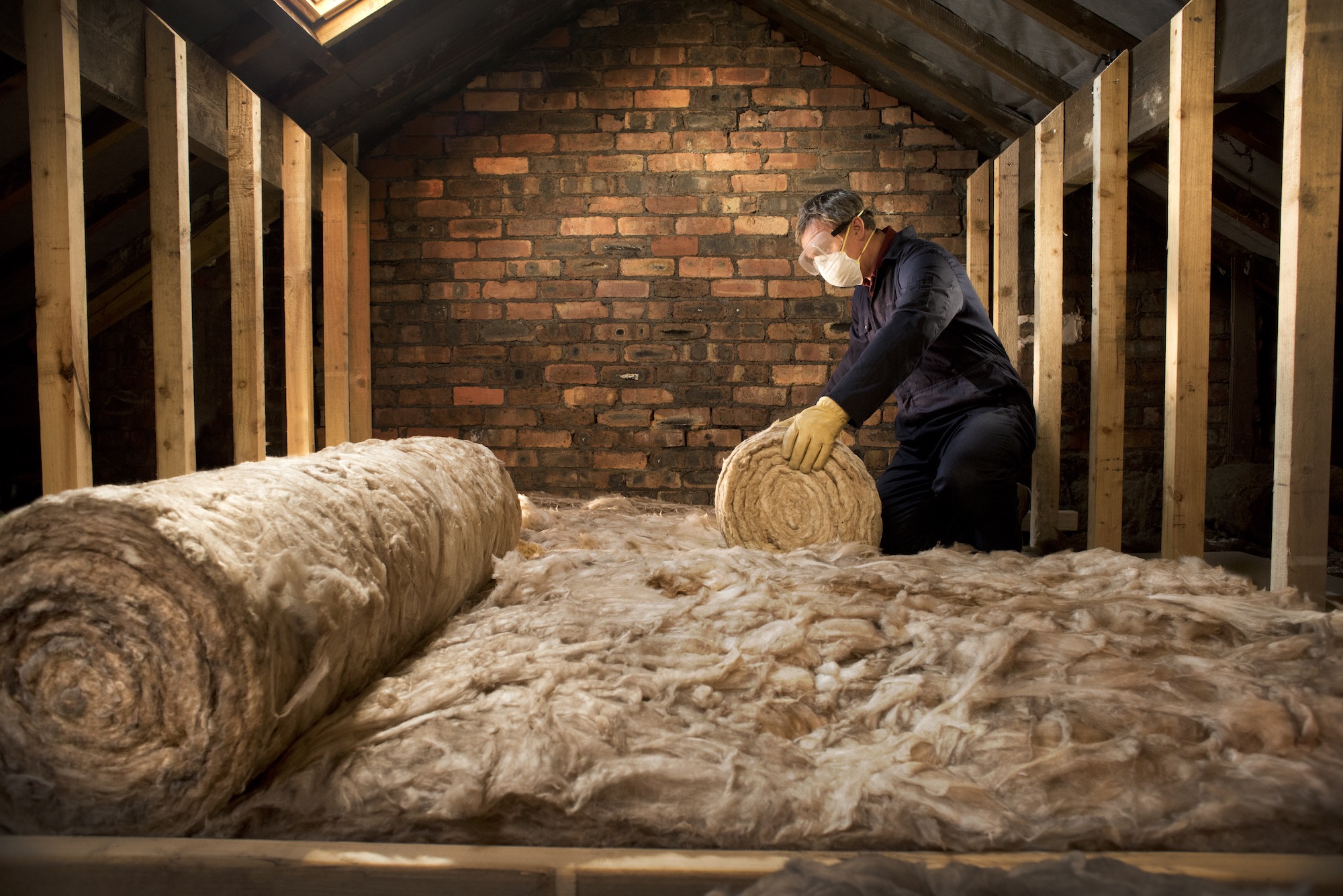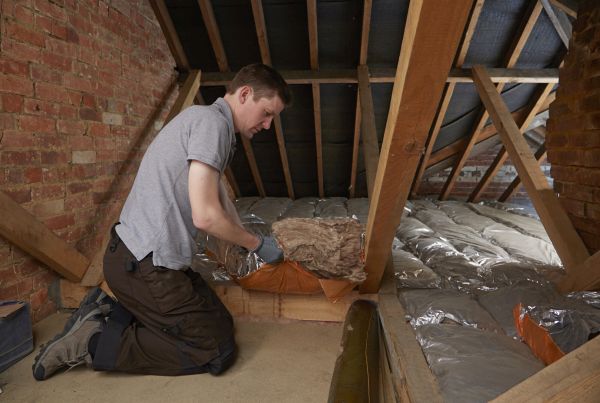Loft insulation
Uninsulated homes lose a quarter of their heat through the roof. With loft insulation, you can keep your home warm and reduce your energy bills.

Loft insulation is one of the easiest and cheapest types of insulation to install, making the loft a great place to start when improving the energy efficiency of your home.
This guide will get you well on the way to stopping heat escaping out of your roof.
What is loft insulation?
Loft insulation is a layer of material between your home’s ceiling and the roof. The insulation material slows down heat as it tries to escape from the top of your home.

How does loft insulation work?
There are several ways to insulate a loft, but each method works on the same principle. You’ll be adding a layer of insulation to stop heat escaping from your roof.
Where you place the insulation layer will determine where the heat gets trapped. If you insulate the floor of the loft, then the heat will stay in the room below. This is known as “cold loft” insulation. If you insulate the top of the loft, then the heat will be stay in the loft itself. This is known as “warm loft” insulation.
Warm loft vs cold loft
Where you choose to put the insulating layer in your loft will create either a ‘warm loft’ or a ‘cold loft’. Whether you want to create a warm or cold loft will depend on what you use the loft for.
Cold loft
Cold loft insulation is a good option if you don’t use your loft at all, or simply use it as a storage space. Since you’re not spending any time up there, there’s no reason to keep it warm.
Types of cold loft insulation
There are several different materials for cold loft insulation:
This is the kind of insulation that comes to mind for most people when they think about insulating a loft. It comes in big rolls which you unroll and lay between the floor joists of the loft. You then add a second layer is across the joists, at a 90 degree angle to the first layer.
If you are comfortable accessing your loft space, you can fit blanket loft insulation yourself. As it’s usually made from rock, glass, or mineral fibre, you’ll need protective gloves, goggles, and a dust mask.
For a more environmentally friendly option, you could choose insulation made from sheep’s wool.
As you may have guessed, you buy this type of insulation ‘loose’. Depending on the material used, it looks a lot like gravel, and you spread it in a similar way. You pour the insulation between the floor joists and rake it to ensure an even level.
Loose fill loft insulation is convenient for insulating hard-to-reach sections of your loft. If the shape of your loft makes it tricky to insulate with blanket insulation, then you may want to use loose fill insulation.
It’s possible to get loose fill insulation that’s made from recycled materials, such as newspaper.
A potential downside to loose fill insulation is, of course, that it’s loose. This means that it might blow around your loft on particularly windy days.
As with cavity wall insulation, material is blown in using a hose. This can be especially useful for lofts which are difficult to access.
Blown fibre loft insulation uses a variety of materials, including fibreglass and cellulose.
This is a professional job – you would need a certified installer to carry it out.
Warm loft
Insulating the roof traps heat in the loft itself. This type of insulation is known as ‘warm loft’. If you use your loft, or if the items you store up there need to be kept warm, then warm loft insulation would be the best choice.
If you use your loft is as a living space, or if you’re planning to convert it into one, you’d insulate it in a slightly different way. See our Room in roof insulation guide below for help with this.
Types of warm loft insulation
There are two different types of insulation for creating a warm loft: sheet insulation and foam insulation.
These are rigid insulation boards, cut to the appropriate size. You install them between the rafters (beams) of the roof.
Remember: Insulating in this way means that you don’t have to raise the level of the floor before boarding it.
Warm loft insulation means that heat won’t be lost through your roof, but it does now have other escape routes. You’ll need to insulate any walls you share with your neighbours (party walls), plus walls which lead outside (gable walls).
You spray foam insulation between the rafters (beams) of the roof. As with sheet insulation, you’ll have to insulate the walls in your loft to make sure the warmth can’t escape through them.
Loft insulation: things to consider
There are a few things to watch out for when insulating your loft. Remember to take the following into account so that your loft insulation is installed safely and effectively.
If you have downlights, you will need to take some fire safety precautions. The heat produced by lightbulbs poses a fire risk if it comes into contact with insulation. In order to protect against this, you can buy downlight covers. These fit over the body of the downlight so the light itself isn’t touching the insulation.
Don’t forget to insulate the loft hatch, as this will prevent both draughts and heat loss.
It’s possible to buy insulated loft hatches, but if you’re on a budget, there are also DIY options.
A simple method is to fill a plastic bag with insulation material, tape it shut, then glue it to the loft-side of the hatch. If the hatch has a hinge or a ladder attached, then make sure that the bag doesn’t interfere with any of the mechanisms.
You can also cut an insulation board to the correct size and shape, then attach this to the hatch. Again, make sure the board doesn’t stop the mechanism from working.
Once you’ve insulated the hatch, you’ll also want to draughtproof around the edges. You can use adhesive draughtproofing strips. Cut these to size and stick them around the edges of the hatch.
If you are creating a cold loft, the lower temperature could make any pre-existing damp problems worse. If loft insulation is your next DIY project, it’s a good idea to speak to a professional about ventilation.
How to floor a loft over insulation
To keep using your loft for storage after insulating between the floor joists, you’ll need to raise the level of the floor.
You can either:
- Fit lengths of wood (battens) across the floor joists. These act like a frame. You then lay and attach the boarding over the frame.
- Fit plastic legs to the floor joists. These essentially act like table legs. The boarding goes over the top, just like the top of a table.
Loft insulation cost and funding
Loft insulation cost
According to the Energy Saving Trust, insulating the loft of a mid-terrace house costs around £560. This price is based on a professional installer insulating the loft with 270mm of mineral wool.
The cost of insulating your loft will vary depending on the size of the loft and what materials you use. Whatever the initial cost, the savings on your energy bills mean the work should pay for itself within two years. Loft insulation has an average life of 40 years, so it’s an incredibly cost-effective addition to your home.
If you’re confident with DIY, you may be able to cut costs further by doing the job yourself.
Loft insulation grants
With a loft insulation grant through our Home Energy Scotland service, you can get up to 75% of the cost of loft insulation covered. Homeowners can get up to £1,500 towards loft insulation.
To apply for a loft insulation grant, simply call Home Energy Scotland on 0808 808 2282. An advisor will help you through the process.
Loft insulation FAQs
You can insulate your loft without losing it as a storage space.
Insulating a loft will create either a ‘warm loft’ or a ‘cold loft’.
With a warm loft, no changes are made to the floor. This means you can carry on using the loft as a storage space just the same as before.
You can still use a cold loft for storage, but first you’ll need to raise the loft floor above the level of the insulation. Doing so makes sure that the flooring boards don’t squash the insulation. It’s important to avoid this, as squashing insulation reduces its effectiveness. It can also lead to condensation problems.
The recommended level of loft insulation is 270mm. If your loft currently has less insulation than this, you can make savings and feel warmer by topping it up. If your insulation is old, it may not be keeping the heat in properly. Replacing the old insulation can save you money and keep you warmer.
Your Energy Performance Certificate (EPC) should show the level of your loft insulation. If you live in Scotland, then you can search for your EPC on the Scottish EPC register website. If you live in England, Wales or Northern Ireland, then you can search for your EPC on the gov.uk website.

Room in roof/one and a half storey insulation
Many houses in the Highlands and Islands of Scotland have a half storey at the top of the property. As with any other living space, this needs to be properly insulated to make sure it’s both warm and energy efficient.
If you have a pitched roof (i.e. a sloping roof which comes to a point) you can use sheet insulation as described above. Once the insulation boards have been fixed between the rafters, they can be plastered over. This gives the room a nice finish.
The walls of the room in the roof can also be insulated using sheet insulation. Again, they can be plastered over for a tidy finish.
If you have a flat ceiling, see the flat roof insulation section below.
Insulating a room in the roof is a job for a professional. It is particularly important that they get the ventilation right in order to avoid any problems with condensation and rot.
Flat roof insulation
Like with loft spaces, roofs can be either ‘warm’ or ‘cold’ depending on how you insulate them.
Warm roof insulation
Insulating from above means you’ll create a warm roof.
The insulation is applied on top of the roof’s timber joists – essentially outside the roof. A vapour barrier is applied to the underside of the insulation. This prevents any issues with rot. A weatherproof layer is added over the top of the insulation.
Cold roof insulation
Insulating from below means you’ll create a cold roof.
The insulation is placed between or below the roof’s timber joists.
Ventilation is especially important when installing a cold roof. If moisture gets trapped in the roof it can lead to issues with rot.

Changeworks delivers Home Energy Scotland in the south east and Highlands and Islands on behalf of the Scottish Government and Energy Saving Trust.
As well as providing free, impartial expert advice to thousands of people every month to help them to keep warm in their homes for less, they identify funding opportunities for households seeking to install energy efficiency measures.
For more information, give Home Energy Scotland a call on 0808 808 2282 or email and the team will be happy to help you.
Useful pages
Is this page useful?